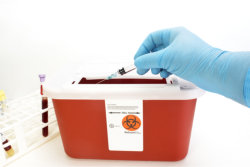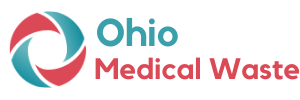
Medical waste disposal is a highly regulated industry in Ohio, and requires multiple state and local licenses to operate. Besides the licenses required, there is a tangle of regulations to deal with depending on the type of facility and the nature of the waste.
On the federal level, there is OSHA (Occupational Safety and Health Administration), the agency that is charged with enforcing workplace safety conditions. Medical Waste often falls into the hazardous materials category, whose handling and disposal and subject to OSHA regulations and enforcement.
Each state and local authority has multiple levels of regulatory supervision overseeing the safe handling of biohazard materials such as sharps (needles, syringes, finger pricks etc.) and infectious materials, which are complex and subject to multiple compliance requirements. Our local Ohio team of waste dispatchers are licensed and approved to dispose of medical waste, making sure you are 100% compliant at all times with Ohio state regulations.
Employee Training
It’s not just the pickup and disposal of the waste that needs to be compliant with all regulations. All employees that come into contact with medical waste are required to go through a periodic training process to prepare them for safe contact with the types of waste. At OhioMedicalWaste.com, our expert teams of workplace safety trainers can train you and your staff on all the requirements of safe medical waste handling and ensure your team is compliant with all the regulations at all times.
Why Choose Ohio Medical Waste?
Choosing the right partner for waste management in Ohio is the key in a highly regulated industry where penalties for violations can be severe. Don’t trust your business to just any provider, call us today and see for yourself how our team is the most trusted partner to handle the entire process of compliance for medical waste.
Our fully compliant service includes:
- Safe, timely pickup
- Workplace compliance training (for safe handling)
- Protective gear is worn on waste pickup and handling
- Off-site proper disposal and destruction of waste in Ohio
About Safety Compliance
Any place of employment typically can be relied upon to both consume resources, and produce waste. The type of each is highly dependent on the field in which the business works. In the case of healthcare, many sorts of businesses can create a unique form of waste. Hospitals, nursing homes, urgent care centers, and similar must deal with dangerous, infectious, and often hazardous forms of waste. This cannot be simply added to the normal waste. Such must be disposed of properly. In order to ensure such is done with standards, the United States Department of Labor created the Occupational Safety and Health Administration (OSHA). As the name implies, this group is dedicated to the safety and health of people in workplaces, regardless of the situation or industry. From industrial to commercial, healthcare to foodservice, OSHA provides necessary resources and guidelines on how to maintain safety. Typically, any workplace that has any form of hazardous materials must display and adhere to a set of rules that are required by OSHA including descriptions of the materials and how to effectively deal with any incidents.
In the healthcare industry, a compliment of unique materials and issues arise. The first is a disproportionate number of ‘sharps,’ or anything that could pierce or cut the skin. Hospitals and urgent care clinics would have need of various needles and scalpels, as well as other similar instruments designed to puncture or cut a person. Nursing homes would have similar issues, though to a lesser degree. All would also have a need to dispose of infectious waste such as bandages, fluid-soaked cloth, or any form of infectious material. Healthcare also means dealing with potentially hazardous materials that could infect others if not disposed of properly. As it is not able to be disposed of normally, this medical waste requires additional steps to either render it inert, unrecognizable, or in some cases both. For the protection of those involved, OSHA has multiple laws in place to ensure the safety of those handling the material. Such plans often involve an exposure control plan to limit and monitor the actual exposure to medical waste.
Risk Management
Regardless of location, OSHA requires a stringent safety program that includes the steps to remain safe around hazardous materials. Such includes keeping detailed records of accidents and locales. This can help to identify individuals or situations that require more caution. This leads into extensive efforts into training for the proper handling and education on hazards in the workplace. In larger institutions, a safety committee is generally formed to oversee such efforts. All equipment must be approved for use by licensed individuals, and biosafety cabinets must be provided by the workplace. Said cabinets must be easily accessed, and in no way blocked or restricted. Visual inspections and walkthroughs should be conducted regularly to ensure the workplace is safe.
Storing and removing risks
Each form of medical waste requires unique procedures in order to remain safe. In the case of sharps, OSHA requires several steps. The first is a red container clearly labeled with the universal symbol for biohazardous material and the word “Biohazard.” This highly recognizable container must be emptied regularly to avoid overfilling, and remain upright. It must be closed immediately before removal or replacement to avoid any spilling of sharps, or having any poke out of the container during transport. If there is a chance of leakage, the container must be put into a secondary container as a precaution that is also sealable and made to prevent leakage. If the container can be opened, it must remain closed during transport to prevent any contents escaping. To that end, duct tape may be used to secure the lid of a sharps container as long as the tape does not serve as the actual lid. OSHA rules say that these containers must be easy to access for employees, and be as close as possible to the point where materials become medical waste. Such is why containers would be in exam rooms, for quick and efficient disposal of the sharps.
By no means are sharps the only form of medical waste generated, but they are unique and require steps for their own sake. The remainder includes biological, infectious, and other forms of medical waste that are a risk to health without breaking the skin. Anything of that nature must be labeled and stored appropriately. Warning labels on containers must use both the biohazard symbol and the term biohazard. Such is as true for any form of container from a bag or container of contaminated laundry, refrigerators/freezers used to store material, or any other container used to ship materials. These labels must be clear and easy to see, warning any nearby of the contents. To that end, the labels are somewhat standardized in appearance. They are a fluorescent orange or orange-red, with the printed term and symbols in a contrasting color. Labels must be part of the container, or affixed as close as possible to the container in a way that makes it difficult to remove to prevent accidental loss of that label. In a pinch, a red bag or container can be substituted for biohazard labels.
Offsite disposal
As medical or regulated waste, it cannot simply be labeled as dangerous and thrown out with the regular refuse. To that end, the common practice is to hire a licensed and professional disposal company that will routinely come to your location and remove the regulated waste for you. As a whole other industry, they also have a host of OSHA regulations to follow as they work on either neutralizing or destroying the waste. Doing so involves either incinerating the materials, using an autoclave to sterilize them, or chemicals to ensure all possible infectious nature is eliminated.

